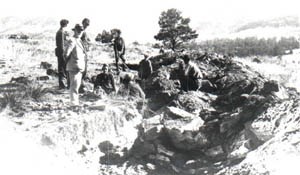Last updated: February 25, 2022
Article
Fossil Cycad National Monument

National Park Service Geologic Resources Division

NPS graphic by Tom Conant.
Lost, But Not Forgotten
On October 21, 1922, President Warren G. Harding created Fossil Cycad National Monument in the Black Hills of South Dakota using the authority provided in the 1906 Antiquities Act. Scientists recognized that the fossil locality, discovered in the 1890s, preserved a significant exposure of a Cretaceous (120 million years old) cycadeoid forest. Hundreds of fossilized specimens--one of the world's greatest concentrations--were exposed at the surface of the site during the late nineteenth and early twentieth centuries. However, years of negligent management at the monument resulted in irreparable impacts on the finite and scientifically significant paleobotanical resources.
History of Fossil Cycad National Monument
When Fossil Cycad National Monument was designated in 1922, the language in the Presidential Proclamation creating stated that it was intended to preserve
"rich Mesozoic deposits of fossil cycads and other examples of paleobotany, which are of great scientific interest and value...it appears that the public interest would be promoted by reserving these deposits as a national monument."
It was the third national monument specifically created to protect fossils, the first and second being Petrified Forest (now a National Park, Arizona) and Dinosaur (Utah and Colorado). Fossil Cycad National Monument was located in north-central Fall River County, southwestern South Dakota, about 11 miles west-southwest of the town of Hot Springs. The site was within the southeastern Black Hills, adjacent to a section of the Black Hills National Forest. The monument originally consisted of 320 acres, and was administered through Wind Cave National Park.

Photo from Yale University archives.
After its creation, fossils exposed on the monument's surface disappeared faster than erosion could expose other specimens from beneath. Fossil cycadeoids were being taken by the thousands for research purposes and to display in museums. The loss of the exposed petrified plant remains eventually left the site devoid of fossils and ultimately without a purpose to justify its existence as a unit of the National Park Service. On September 1, 1957, the United States Congress voted to de-authorize Fossil Cycad National Monument.
Paleontology in Fossil Cycad National Monument
The namesake for the monument, Fossil Cycad, is actually a scientific misnomer. The fossil plants preserved at the site are actually "cycad-like" cycadeoids, also known as Bennettitales to paleobotanists. This confusing nomenclature in no way diminishes the scientific importance of these extremely well-preserved plants which shared the Cretaceous world with dinosaurs and were likely eaten by them. The excellent preservation of the "Minnekahta cycads" yields morphological details and reproductive structures that had not been documented in fossil cycadeoids from anywhere else around the world. These fossils enabled researchers to more fully understand an otherwise unknown portion of the plant fossil record.

Sketches from Wieland's American Fossil Cycads (vol. 2, 1916)
In 1897, a young paleontology student at Yale University named George Reber Wieland began a life-long interest in fossil cycadeoids. While assisting O.C. Marsh, Professor of Paleontology at Yale, Wieland travelled to South Dakota and met Lester Ward. Through the encouragement of Marsh and Ward, Wieland's scientific interests in the Minnekahta cycads grew. He changed his focus from vertebrate paleontology to paleobotany. Wieland discovered that the cycadeoid trunks from the monument preserved flowers and cones containing fruit, which had never been seen in the fossil record before. The flowers and fruit were actually contained within the trunks of the cycadeoids. After working in South Dakota, Wieland returned to Yale and the Peabody Museum and continued to study the cycadeoids. He later wrote a two volume book titled American Fossil Cycads, published by the Carnegie Insitution of Washington in 1906 and 1916.
Learn More
- Santucci, V.L. and J.M. Ghist, 2014. Fossil Cycad National Monument: A History From Discovery to Deauthorization. Proceedings of the 10th Conference on Fossil Resources. Dakoterra 6: 82-93. https://irma.nps.gov/DataStore/Reference/Profile/2274104
